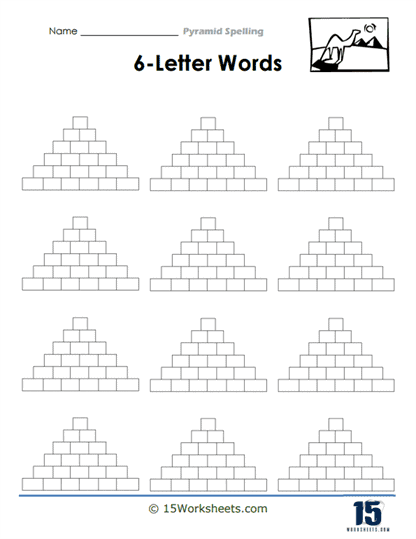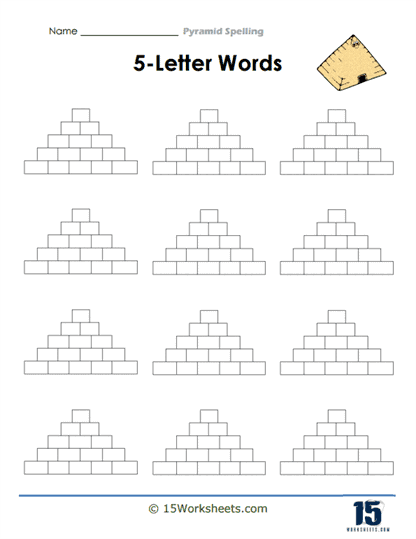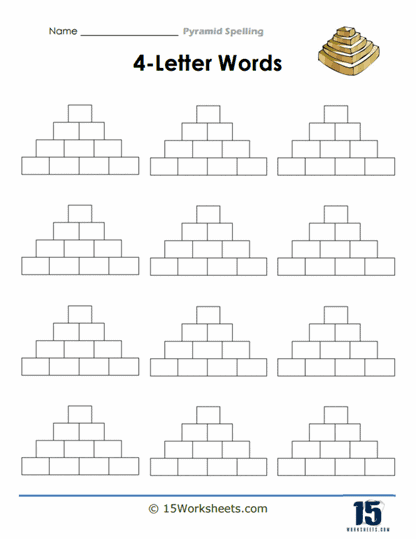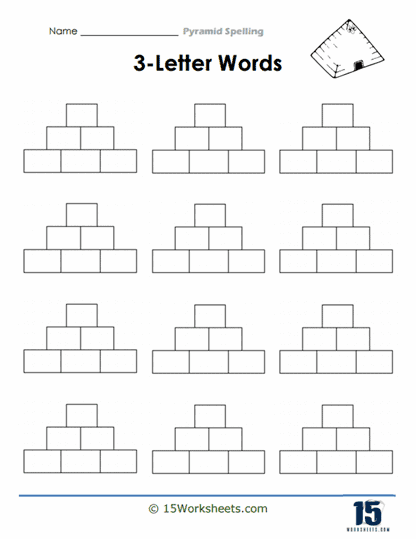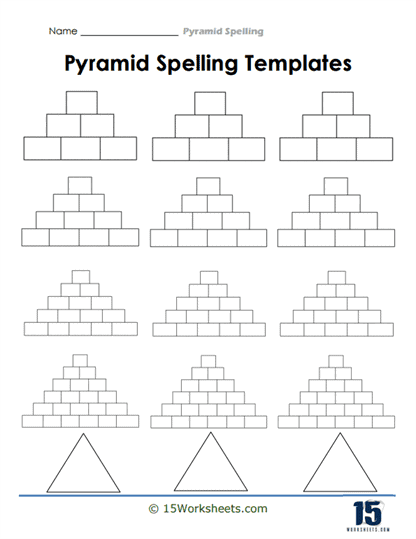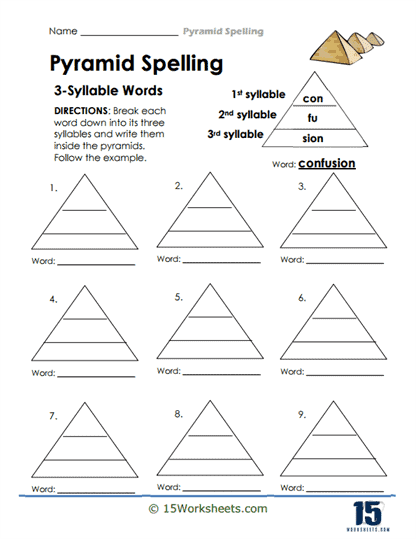Pyramid Spelling Worksheets
All About These 15 Worksheets
These worksheets offer an innovative and interactive method for teaching spelling that combines visual, kinesthetic, and cognitive learning strategies. By guiding students to build words one letter at a time in a pyramid-like structure, these worksheets help demystify spelling and provide a systematic approach to word construction. For instance, when spelling the word “cat,” a student would begin by writing “C” on the first row, then “Ca” on the second, and finally “Cat” on the third. This step-by-step process not only breaks the word into digestible parts but also ensures that each letter is carefully considered, promoting accuracy and confidence in spelling.
What is Pyramid Spelling Technique?
It is an engaging and structured approach to teaching spelling that helps students build words letter by letter in a visual pyramid format. This method involves starting with the first letter of a word on the top row, then adding one additional letter on each subsequent row until the full word is spelled. For instance, for the word “dog,” a student would write “D” on the first row, “Do” on the second, and “Dog” on the third, creating a triangular shape. This incremental process encourages students to focus on each letter and its position within the word, promoting accuracy and attention to detail. The visual layout reinforces the sequence of letters, making it easier for learners to remember the correct spelling.
Pyramid spelling is particularly effective because it caters to a variety of learning styles and strengthens key literacy skills. Visual learners benefit from seeing the word develop step by step, while kinesthetic learners engage with the material through the act of writing. Additionally, the technique fosters a sense of accomplishment, as students can see their progress unfold with each row they complete. By combining repetition, structure, and a visually appealing format, Pyramid Spelling provides an enjoyable and effective way for learners to improve their spelling, letter recognition, and overall confidence in language skills.
A notable advantage of these sheets is their ability to accommodate diverse learning styles, making them a highly adaptable educational tool. Visual learners benefit from the clear, incremental arrangement of letters, which allows them to see how a word takes shape progressively. Kinesthetic learners, on the other hand, thrive on the physical act of writing, which reinforces memory through tactile engagement. Additionally, logical learners are drawn to the structured and orderly nature of the exercise, which aligns with their preference for systematic learning. This versatility ensures that Pyramid Spelling Worksheets can meet the needs of students with varied preferences and strengths, whether in a traditional classroom or a homeschool setting.
The gradual buildup of a word creates a visual representation of their learning journey, reinforcing their confidence and motivation to tackle more complex words. This sense of achievement is particularly valuable for students who may struggle with spelling, as it shifts the focus from rote memorization to an engaging, step-by-step process. Teachers and parents can also use these worksheets as a diagnostic tool to identify specific areas where a student might need extra practice, such as recognizing vowel patterns or mastering consonant blends.
These worksheets offer more than just a way to improve spelling-they also enhance letter recognition and word familiarity. By methodically writing and constructing a word letter by letter, students gain an intimate understanding of the word’s structure and sequence. This repetitive process is especially beneficial for younger learners or those who struggle with spelling, as it provides a structured way to reinforce correct spelling patterns. Over time, as students repeatedly engage with these exercises, they not only memorize specific words but also develop a stronger overall grasp of language patterns, leading to increased confidence in their spelling and writing abilities.
A significant advantage of this type of work is its adaptability, which allows them to meet the needs of diverse learners and educational contexts. Teachers and parents can easily customize these worksheets to align with the age, skill level, or interests of their students. For instance, three-letter words such as “cat” or “dog” are perfect for beginners, while longer and more complex words like “exciting” or “beautiful” provide an appropriate challenge for advanced learners. Moreover, educators can tailor the content to specific themes or lessons, integrating vocabulary from subjects like science, history, or holidays. This thematic approach not only enhances relevance but also helps students see connections between spelling and their broader studies.
The sense of accomplishment that Pyramid Spelling Worksheets foster is another key benefit. As students progress from writing a single letter to completing a full word, they experience a tangible sense of achievement. This visual and sequential process provides a clear representation of their progress, boosting their confidence and encouraging further effort. The pyramid structure itself, which resembles a fun and engaging puzzle, can transform the activity from a routine spelling drill into an enjoyable challenge. This can be particularly motivating for reluctant learners, who might otherwise feel intimidated or disengaged by traditional methods.
The methodical nature of building words one letter at a time encourages students to slow down and think carefully about each step. This deliberate approach reduces careless mistakes and reinforces accuracy, helping students internalize correct spelling patterns. By fostering mindfulness in the learning process, these worksheets not only improve spelling but also nurture habits that can benefit students across various academic tasks.
The versatility of this work also makes them a practical and accessible resource for educators and parents. They are simple to create, requiring only basic materials like paper and pencils, yet they provide a highly effective learning experience. For added convenience, pre-designed templates are often available online, saving preparation time while still allowing for customization. Whether used as a standalone activity or integrated into a broader lesson plan, these worksheets can seamlessly fit into daily learning routines without requiring significant effort or expense.

